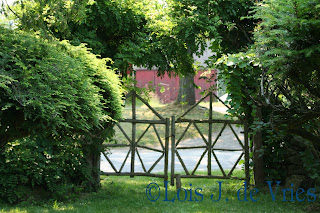Antique Gates

This antique gate stands at the end of a wisteria-covered pergola and is attached to concrete pillars although, since the pergola itself is constructed of cedar logs, the gates could have been hung from cedar posts, as well. It is a formal exclamation point at the end of a traditional garden structure. It serves the practical purpose of separating this part of the garden from the county road, although it is unlikely that anyone would ever enter the garden this way. But it also serves a specific design purpose. Long, shaded pergolas such as this one provide a sense of enclosure that is similar to a tunnel. The gate is the “light” at the end of it. It serves as a focal point, or resting place, for the eye and implies that the narrow vista is about to open up. The gate could just as easily serve as the entry to an area of open lawn, or a seating area enclosed by hedges. If your heart’s desire is an antique gate, be prepared to pay a hefty price. Most architectural salvage firms host websi...

